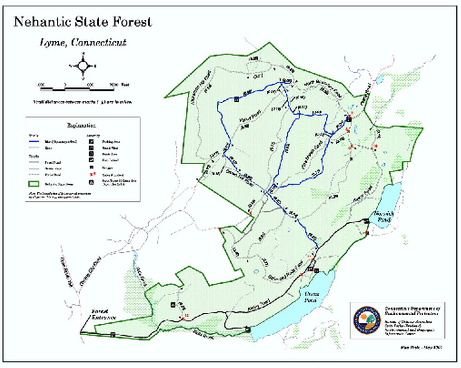
A presentation of the proposed 10-year Forestry Plan for Nehantic State Forest will be given from 3 to 5 p.m. Wednesday in the auditorium of Old Lyme’s Memorial Town Hall. The Old Lyme Open Space Commission and the Old Lyme Land Trust are hosting the event. All are welcome to attend.
Emery Gluck from the Division of Forestry, Bureau of Natural Resources, Department of Energy and Environmental Protection, will open by discussing, “Management Goals and Proposed Bio-Indicators for Nehantic State Forest Management Plan”
The next speaker will be Margo Burns, Environmental Planner for the Lower Connecticut River Council of Governments, who will present, “The Lower Connecticut River and Coastal Region Natural Resource Base Strategic Conservation Plan: A GIS Overlay Analysis”
Tom Worthley, UConn Extension Forester, will discuss, “Background and Rationale for Managing Forests,” and Lisa Wahle from the DEEP Wildlife Division’s will present, “Connecticut’s New England Cottontail Program.”
Other speakers will include Dick Raymond, a DEEP Forestry, Municipal and Private Lands Forester for New London, Tolland and Windham Counties and Elizabeth Robinson, Land Steward for The Nature Conservancy Eight Mile River Watershed.
All are welcome to attend the program. An open discussion will follow the presentations.
The goals of the Nehantic State Forest Resource Management Plan are:
1) To promote biological diversity (viable populations of all forest species of plants and animals native to the area) by promoting upland ecosystems and populations that are not adequately sustaining themselves under current conditions.
2) Maintain or improve aquatic system integrity
3) To promote healthy and sustainable forests
Indicators will be used to measure and monitor progress toward the management goals. Proposed indicators use a “Bio-diversity Scorecard” format developed by the Manomet Center for Conservation Sciences as a guide. It can be found at A Forest Biodiversity Scorecard
A landscape wide approach has been incorporated into the plan so management strategies in Nehantic take into account the condition and trends of the surrounding forest.
The plan will follow a “natural disturbance model of management” to promote biodiversity.
The model uses nature as a guide for management. A combination of active and passive management will be used to promote an array of all the different forest types and structures that have historically sustained all native plant and animal populations.
Active management generally involves trees harvests. Background information can be found at DEEP: Why We Harvest Trees in Connecticut State Forests and DEEP: Young Forest and Shrubland Initiative